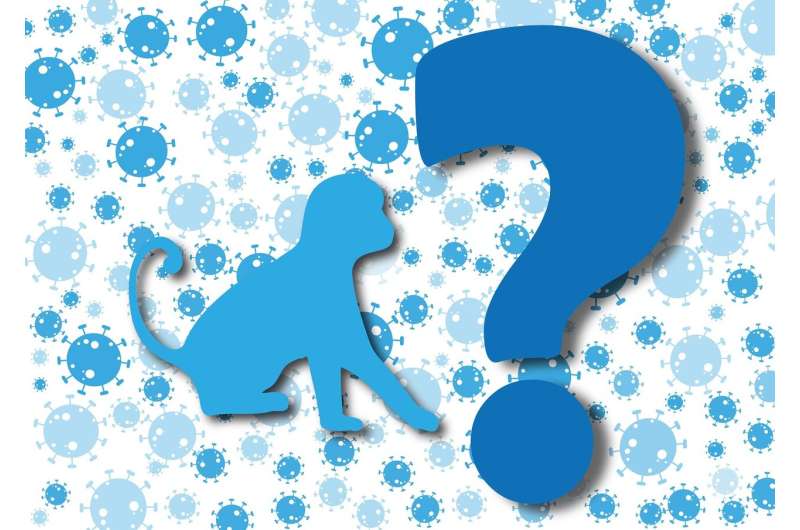
As more monkeypox infections are identified throughout the U.S. and the world, the public is more curious about the disease, especially because we are still in a global pandemic. Epidemiologist and professor at George Mason University Dr. Amira Roess answers more questions about monkeypox’s transmissibility, similarities to COVID-19, why it’s spreading now, and other questions the public should know.
Roess specializes in infectious diseases like COVID-19 and monkeypox, especially reducing the transmission of diseases that originate through animal-human contact. Roess investigated and responded to poxviruses infections, including monkeypox, in 2008 while serving as an Epidemic Intelligence Service officer at the Centers for Disease Control (CDC).
See the previous tip sheet from Dr. Roess: “What to Know About Monkeypox and the Potential for an Outbreak in the U.S.,” to learn more about how the disease spreads and how to prevent it.
Is monkeypox the next pandemic?
This outbreak, while global, may not evolve to a pandemic at the same magnitude as COVID-19 given a few key things. First, it is not as transmissible as COVID-19. Transmission is really limited to close physical contact during the infectious period. Many infected individuals end up with a rash and this makes it easier for individuals to realize that they have it and seek care. Health care workers and health departments across the world are now aware of monkeypox and what needs to be done if there is a suspected case. This means that there is a chance to stop transmission. For as long as the virus remains this way and health care workers and health departments have the resources to respond, we have a chance of controlling this and preventing a large-scale pandemic. If we lose momentum to contain the viral spread then we could see more cases.
Is monkeypox as easily transmitted as COVID-19?
Our previous experience with monkeypox has demonstrated that it is less transmissible than the current variants of the COVID-19 virus circulating. Like COVID-19, monkeypox is transmissible through close contact with infected individuals, especially close physical contact, which means we will see more close contacts and health care workers and their close contacts infected before the outbreak is behind us.
Will monkeypox turn into the next COVID-19? Will a shutdown be necessary to prevent spread?
The COVID-19 virus is a novel one, meaning we had not seen it previously and thus had no scientific or medical experience with it. We relied on our knowledge and experience with other coronaviruses and respiratory pathogens to guide early decision making. We know more about the monkeypox virus, although a lot less than we would like to know.
Governments and global leaders are well aware of the global pandemic fatigue and are hesitant to impose similar measures to control monkeypox as they did the COVID-19 virus. Our previous experience suggests that because monkeypox is less transmissible than COVID-19 it will not be necessary to impose stay-at-home orders or restrict movement at the scale that we have seen. Recommendations and precautions could evolve, if for example, the virus evolves, or changes, and we end up with into a more transmissible strain or a more virulent strain of monkeypox, then we will have to change strategies. But this seems improbable given the current epidemiologic situation.
Objective and factual information from a reputable source like the World Health Organization, the CDC, or a local health department is really all that most of us need. Knowing what is happening locally is very important. For example, if there is a local case of monkeypox in your town, the health department will conduct contact tracing as quickly as possible to make sure that individuals are notified, can quarantine, and receive care as quickly as possible.
Is monkeypox a sexually transmitted disease?
A large number of individuals involved in the current outbreak were exposed to sexual partners who were infected. This does not mean that it is a sexually transmitted infection in the strict sense. For an infection to be sexually transmitted we expect that infectious virus would be transmitted through semen and vaginal fluids. So far, we have not detected virus in these fluids, but this requires much more study.
When we saw outbreaks in west and central Africa and in the US in 2003, what often happened was that an individual became exposed to monkeypox from handling an infected animal and then became infected themselves. The infected individual then went on to infect household members through close contact and even health care workers who were caring for them. We are seeing something similar now in many countries.
Why is monkeypox spreading more now than before?
We’ve dealt with numerous monkeypox outbreaks over the last few decades, since monkeypox virus was first identified in the late 1950s. Monkeypox outbreaks tend to burn themselves out, and historically that was due to the limited chain of transmission from the point of the spillover event to the close contacts of the first human case. However, increased encroachment into wildlife areas, combined with rapid urbanization and globalization means that we will see elongated chains of transmission.
The patients identified in Europe and elsewhere were misdiagnosed in some cases as having syphilis or herpes and given treatments that would not work against monkeypox. Health care workers outside of Africa, rarely, if ever, think about monkeypox; and why would they when most have never seen it and most were trained by doctors who also had never seen it. This all meant that the current outbreak went undetected for a while and, unfortunately, we will see more close contacts and health care workers and their close contacts infected before the outbreak is behind us.
Source: Read Full Article
